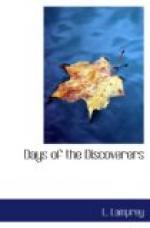“Sometimes,” he said to himself, “one hastens a catastrophe by warning people of it, but then, that may be because it could not have been prevented. Cortes is inclined to make that simple fellow his aide because they are so unlike, and so, I suspect, are others. At any rate I have done my best to make him see whose leadership is safest.”
The fleet was a rather imposing one for those waters. There were eleven ships altogether, the flagship and three others being over seventy tons’ weight, the rest caravels and open brigantines. These were manned by one hundred and ten sailors, and carried five hundred and fifty-three soldiers, of whom thirty-two were crossbowmen and thirteen arquebusiers. There were also about two hundred Indians. Sixteen horses accompanied the expedition, and it had ten heavy cannon, four light field-guns, called falconets, and a good supply of ammunition. The horses cost almost more than the ships that carried them, for they had been brought from Spain; but their value in such an undertaking was great.
Hernando Cortes had come out to Cuba when he was nineteen, and that was fifteen years ago. Much had been reported concerning an emperor in a country to the west, who ruled over a vast territory inhabited by copper-colored people rich in gold, who worshiped idols. Cortes had observed that Indian tribes, like schoolboys, were apt to divide into little cliques and quarreling factions. If the subject tribes did not like the Emperor, and were jealous of him and of each other, a foreign conqueror had one tool ready to his hand, and it was a tool that Cortes had used many times before.
The people of this coast, however, were not at all like the gentle and childlike natives Colon had found. From the rescued captive Aguilar, the commander learned much of their nature and customs. On his first attempt to land, his troops encountered troops of warriors in brilliant feathered head-bands and body armor of quilted white cotton. They used as weapons the lance, bow and arrows, club, and a curious staff about three and a half feet long set with crosswise knife-blades of obsidian. Against poisoned arrows, such as the invaders had more than once met, neither arquebus nor cannon was of much use, and body armor was no great protection, since a scratch on hand or leg would kill a man in a few hours. After some skirmishing and more diplomacy, at various points along the coast, Cortes landed his force on the island which Grijalva had named San Juan de Ulloa, from a mistaken notion that Oloa, the native salutation, was the name of the place. The natives had watched the “water-houses,” as they called them, sailing over the serene blue waters, and this tribe, being peaceable folk, sent a pirogue over to the island with gifts. There were not only fruits and flowers, but little golden ornaments, and the Spanish commander sent some trinkets in return. In endeavoring to talk with them Cortes became aware of an unusual




